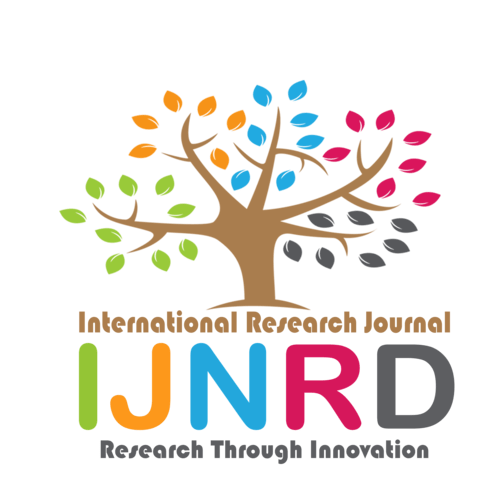|
|||||||||||||||

|
INTERNATIONAL JOURNAL OF NOVEL RESEARCH AND DEVELOPMENT International Peer Reviewed & Refereed Journals, Open Access Journal ISSN Approved Journal No: 2456-4184 | Impact factor: 8.76 | ESTD Year: 2016 Scholarly open access journals, Peer-reviewed, and Refereed Journals, Impact factor 8.76 (Calculate by google scholar and Semantic Scholar | AI-Powered Research Tool) , Multidisciplinary, Monthly, Indexing in all major database & Metadata, Citation Generator, Digital Object Identifier(DOI) |
||||||||||||||
Issue: April 2024
Volume 9 | Issue 4
Review Result and Publication of Paper within : 2-3 days
Click Here For more DetailsFor Authors
Forms / Download
Published Issue Details
Editorial Board
Other IMP Links
Facts & Figure
Impact Factor : 8.76
Issue per Year : 12
Volume Published : 9
Issue Published : 95
Article Submitted :
Article Published :
Total Authors :
Total Reviewer :
Total Countries :
Indexing Partner
Join RMS/Earn 300
Licence
This work is licensed under a Creative Commons Attribution-NonCommercial 4.0 International License







|
Published Paper Details
|
|
| Paper Title: | Sexual and Reproductive Health in India |
| Authors Name: | Aadil Tariq Shah |
| Download E-Certificate: | Download |
| Author Reg. ID: |
IJNRD_188022
|
| Published Paper Id: | IJNRD2303224 |
| Published In: | Volume 8 Issue 3, March-2023 |
| DOI: | |
| Abstract: | India has demonstrated a commitment to improving the sexual and reproductive health of its population. Its policy and program environment has moved from a narrow focus on family planning to a broader focus emphasizing sexual and reproductive health and the exercise of rights. Great progress has been made. The total fertility rate is 2.2 (2015-2016), reaching substitution levels in 18 of her 29 states. The country's age structure is well positioned to enjoy the demographic dividend. Maternal, neonatal and perinatal mortality rates have declined, child marriage has declined sharply, contraceptive use and skilled labor care during childbirth have increased, and estimates of HIV prevalence are higher than the situation before. suggesting that it is not as dire as had been assumed. But there is still a long way to go. Despite impressive improvements, pregnancy-related outcomes remain unacceptably high in terms of both maternal and neonatal mortality and morbidity. Many women do not have access to care after giving birth. Patterns of contraceptive practice reflect a continued focus on female sterilization, limited use of male methods, limited use of endless methods, and ongoing unmet needs. The vast majority of abortions are performed outside the structure of legally licensed providers and facilities. More than a quarter of young women remain married during childhood. Few young people have access to comprehensive sex education, and their information needs to promote sexual and reproductive health are generally unmet. Access to and quality of services and making informed choices are far from optimal. Injustice is pervasive and places the poor, rural residents, young people and marginalized groups at particular disadvantage, not just in certain areas. To move forward, and in particular to achieve the national goals and her SDGs 3 and 5, multi-faceted efforts are needed to accelerate the pace of change in all these aspects of health and rights. |
| Keywords: | sexual and reproductive health sexual and reproductive rights pregnancy and maternal health family planning and contraception induced abortion adolescent and youth health gynaecological morbidity and RTI and STI India policies and programs |
| Cite Article: | "Sexual and Reproductive Health in India", International Journal of Novel Research and Development (www.ijnrd.org), ISSN:2456-4184, Vol.8, Issue 3, page no.c156-c178, March-2023, Available :http://www.ijnrd.org/papers/IJNRD2303224.pdf |
| Downloads: | 000118754 |
| ISSN: |
2456-4184 | IMPACT FACTOR: 8.76 Calculated By Google Scholar| ESTD YEAR: 2016 An International Scholarly Open Access Journal, Peer-Reviewed, Refereed Journal Impact Factor 8.76 Calculate by Google Scholar and Semantic Scholar | AI-Powered Research Tool, Multidisciplinary, Monthly, Multilanguage Journal Indexing in All Major Database & Metadata, Citation Generator |
| Publication Details: |
Published Paper ID:IJNRD2303224 Registration ID: 188022 Published In: Volume 8 Issue 3, March-2023 DOI (Digital Object Identifier): Page No: c156-c178 Country: Srinagar, JAMMU AND KASHMIR, India Research Area: Medical Science Publisher : IJ Publication Published Paper URL : https://www.ijnrd.org/viewpaperforall?paper=IJNRD2303224 Published Paper PDF: https://www.ijnrd.org/papers/IJNRD2303224 |
| Share Article: | |
|
Click Here to Download This Article |
|
| Article Preview | |
|
|
|
Major Indexing from www.ijnrd.org
| Semantic Scholar | Microsaoft Academic | ORCID | Zenodo |
| Google Scholar | ResearcherID Thomson Reuters | Mendeley : reference manager | Academia.edu |
| arXiv.org : cornell university library | Research Gate | CiteSeerX | PUBLON |
| DRJI | SSRN | Scribd | DocStoc |
ISSN Details
 |
 |
ISSN: 2456-4184
Impact Factor: 8.76 and ISSN APPROVED
Journal Starting Year (ESTD) : 2016
DOI (A digital object identifier)
Conference
Open Access License Policy
Important Details
Social Media
| Copyright © 2024 - All Rights Reserved - IJNRD |












Facebook Twitter Instagram LinkedIn